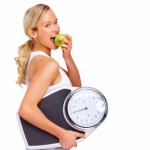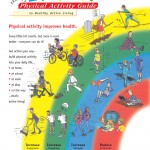A refreshing health-conscious treat.

Ingredients
- 3 apples, diced (sweet varieties pair better with the tartness of the yogurt)
- 3 cups nonfat plain Greek yogurt
- 1/2 cup flaxseeds (ground)
- 4 tsp maple syrup or honey – use more or less to taste
- 3/4 cup sultana raisins
- ¼ cup walnuts, chopped
- dash of cinnamon
Preparation
- Set out 4 glasses or bowls.
- In each, layer 1/4 chopped apple, 1/4 cup yogurt, 2 tsp ground flaxseeds, and 1 tbsp raisins twice in each glass.
- Drizzle each parfait with 1 tsp of maple syrup or honey, and sprinkle with chopped walnuts and cinnamon.
Nutrition per serving
- 13g protein
- 6g fiber
- 4g fat (0 saturated)
- 265 calories
Serves 4
The weight loss industry is one of the fastest growing in the western world. There are countless rule books telling us what, when and how much to eat in order to lose. But who is making these “rules”? Before following the rules of so-called dieting experts, you need to find out if they even make sense.
Some dieting rules make sense on the surface, but they can impart a sense of rigidity to your weight loss journey. Rigidity leaves little space for temptation or real life, and before you know it you find yourself having that on again/off again relationship with your diet. If you’re like most people, the “off again” phase is loaded with guilt and feelings of personal failure.
Let’s examine some of these rules that are causing us to feel badly when we break them.
Never eat after 7 p.m.
 Your metabolism does not shut off at 6:59 p.m. It is true, however, that most people who struggle with weight loss tend to eat most of their calories in the evening. Mindless TV snacking does not happen because we are hungry, but because we are bored, tired, used to it or simply have had a hard day and “deserve it”.
Your metabolism does not shut off at 6:59 p.m. It is true, however, that most people who struggle with weight loss tend to eat most of their calories in the evening. Mindless TV snacking does not happen because we are hungry, but because we are bored, tired, used to it or simply have had a hard day and “deserve it”.
Rather than sticking to the exact time, ask yourself if are you hungry. Is it stomach hunger? Mouth hunger, when you feel like tasting something delicious? Emotional hunger, when you are feeling lonely? If you truly are hungry, go ahead and make yourself a meal. Keep in mind this meal should be smaller because your day is coming to a close and you are not likely to be very physically active.
If you are not truly hungry, think about where that need to eat is coming from. This will help you identify some of the triggers that may lead to over-eating and may help you change your eating habits over the long term.
Follow your diet all week, and reward yourself with a “cheat day”.
To put this rule into perspective, consider this: Most moderate weight loss plans encourage a 500-calorie deficit each day to achieve a loss of one pound per week (3,500 calorie deficit = approximately one pound of body fat). That deficit can easily be undone with one indulgent meal out if you are not paying attention.
While a little bit of indulgence is important—and I would argue necessary—this rule seems to encourage all-or-nothing thinking. Not only can over-indulging on weekends slow or reverse your weight loss efforts, but dieting during the rest of the week can make you feel like you’re in a never-ending deprivation cycle. Personally, I prefer enjoying a little bit of my favourite foods every day, mindfully and in moderation.
Carbs are bad/fat is bad/(insert food here) is bad
This type of thinking can lead to feelings of deprivation, guilt, craving and ultimately overeating. One small bag of potato chips in one week and a family-size bag of potato chips every day are two very different things. I always like to remind my clients that there are no bad foods— just bad overall diets! Any food can fit into a healthy diet if you use moderation and balance as guiding principles.
Overall, a balanced and intuitive approach to eating is key to healthy and sustainable weight loss. Instead of worrying about breaking hard and fast dieting rules (which all of us will, sooner or later) examine your feelings and eating behaviours to better understand when, why, what and how you eat. You will gradually create a more forgiving and flexible approach that will both nourish your body and nurture your soul.
Hyperpigmentation or melasma is an increase of melanin in the melanocytes or colour cells. It can affect any part of the body, but is most common on the face, affects all skin types and, although common in men, is more prevalent in women.
 Although hyperpigmentation/melasma is rarely harmful, it can affect your self-esteem. If you or someone you know is suffering from this problem, you should know that there are effective methods for minimizing and ridding the skin of pigment.
Although hyperpigmentation/melasma is rarely harmful, it can affect your self-esteem. If you or someone you know is suffering from this problem, you should know that there are effective methods for minimizing and ridding the skin of pigment.
There are number of factors that cause hyperpigmentation or melasma. These include hormones, acne, photosensitive medications, and sun damage, which is the most common culprit.
One option for treatment is topical prescription cream. The active medication is hydroquinone and a retin A. Hydroquinone is a lightening agent that will lighten the over-active melanin in the skin. It also blocks the stimulation of pigment production. Retin A stimulates new cells and sloughs away the old, dead, surface cells. It will take time to see full results, just as the pigmentation formation also took time to form.
Chemical peels such as the spot peel are also effective in lightening pigmentation. The spot peel uses a retinol and salicylic acid base to exfoliate. Two weeks before the peel, it is important to prepare the skin with the appropriate topical prescribed creams. Peels are also very beneficial in preparing the skin for topical lightening and exfoliants.
Intense Pulse Light Therapy (photo facials) is highly effective in managing hyperpigmentation caused by sun damage. The light energy is attracted to the dark spots and causes them to crust, turn dark and fall off. The pigmentation spots look like coffee grounds on the treated areas for a short period. Multiple treatments may be required.
Once hyperpigmentation has faded, the melanocytes will always remember the damage even if it is not visible on the skin’s surface. SPF UVA/UVB is the number one protector against hyperpigmentation returning. Other methods of sun protection include using a hat, covering up, and avoiding mid-day sun exposure. Even in the winter, SPF 30 UVA/UVB is strongly encouraged.
You know physical activity is good for you. But did you know that regular physical activity actually prevents chronic diseases and premature death? Physically active people are healthier people, and research is showing that the more active you are, the healthier you are.
 For many years, doctors recommended rest and physical inactivity for people with chronic disease. Today, secondary prevention studies clearly show that physical activity has positive effects on the disease process.
For many years, doctors recommended rest and physical inactivity for people with chronic disease. Today, secondary prevention studies clearly show that physical activity has positive effects on the disease process.
Physical inactivity is a modifiable risk factor for cardiovascular disease, diabetes mellitus, cancer (colon and breast), obesity, hypertension, bone and joint disease (osteoporosis and osteoarthritis), and depression.
How exercise impacts your health
Regular physical activity has been shown to improve body composition by reducing abdominal adiposity and improving weight control, and to enhance lipid lipoprotein profiles by reducing triglyceride levels, increasing HDL cholesterol levels and decreasing LDL cholesterol levels. It also improves glucose homeostasis and insulin sensitivity, reduces blood pressure, improves autonomic tone, reduces systemic inflammation, decreases blood coagulation, improves coronary blood flow, augments cardiac function and enhances endothelial function (Warburton et al., 2006).
The current activity guidelines promoted by Health Canada and the Canadian Society of Exercise Physiology are adequate to reduce health risks. If you engage in activity above the recommended guidelines the health benefits will be even greater. Even children can improve their health significantly since the risk of chronic disease starts in childhood and increases with age.
Physical Activity Guidelines (CSEP, 2011)
Children: 5-11 years
For health benefits, children aged 5-11 years should accumulate at least 60 minutes of moderate to vigorous-intensity physical activity daily. This should include vigorous-intensity activities at least 3 days per week and activities that strengthen muscle and bone at least 3 days per week. Moderate-intensity physical activities will cause children to sweat a little and to breathe harder (i.e., bike riding and playground activities). Vigorous-intensity physical activities cause children to sweat and to be ‘out of breath’ (i.e., running and swimming).
Youth: 12-17 years
For health benefits, youth aged 12-17 years should accumulate at least 60 minutes of moderate to vigorous-intensity physical activity daily. This should include vigorous-intensity activities at least 3 days per week and activities that strengthen muscle and bone at least 3 days per week. Moderate-intensity physical activities will cause teens to sweat a little and to breathe harder (i.e., bike riding and skating). Vigorous-intensity physical activities with cause teens to sweat and to be ‘out of breath’ (i.e., running and rollerblading).
Adults: 18-64 years
To achieve health benefits, adults aged 18-64 should accumulate at least 150 minutes of moderate to vigorous-intensity aerobic physical activity per week, in bouts of 10 minutes or more. It is also beneficial to add muscle and bone strengthening activities using major muscle groups at least 2 days per week. Moderate-intensity physical activities will cause adults to sweat a little and to breathe harder (i.e., bike riding and brisk walking). Vigorous-intensity physical activities with cause adults to sweat and to be ‘out of breath’ (i.e., jogging and cross-country skiing).
Older Adults: 65 years and older
To achieve health benefits, and improve functional abilities, adults aged 65 and older should accumulate at least 150 minutes of moderate to vigorous-intensity aerobic physical activity per week in bouts of 10 minutes or more. It is also beneficial to add muscle and bone strengthening activities using major muscle groups, at least 2 days per week. Those with poor mobility should perform physical activities to enhance balance and prevent falls. Moderate-intensity physical activities will cause older adults to sweat a little and to breathe harder (i.e., bike riding and brisk walking). Vigorous-intensity physical activities with cause older adults to sweat and to be ‘out of breath’ (i.e., swimming and cross-country skiing).
If you would like to ensure that you are getting the healthy benefits of physical activity, call us today. We’ll create an individualized fitness plan, including specific activity guidelines, to help you look and feel your very best.
